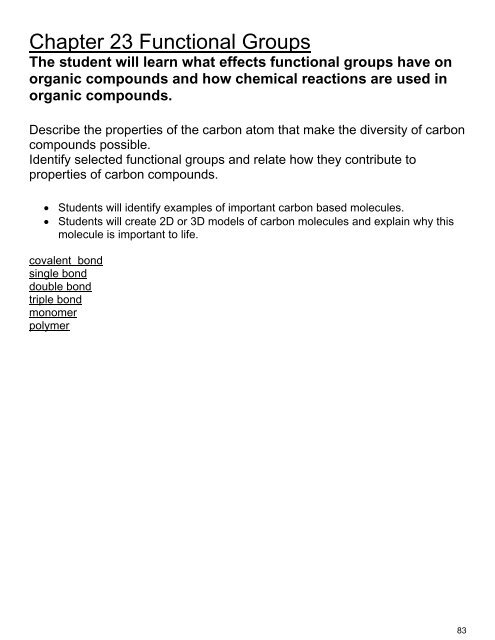Create successful ePaper yourself
Turn your PDF publications into a flip-book with our unique Google optimized e-Paper software.
case, we count two things stuck to carbon, because we only count the atoms, NOT the number of<br />
bonds.<br />
Likewise, with ammonia there are four things. Three of the things on nitrogen are hydrogen atoms<br />
and the fourth is a lone pair. For the purposes of VSEPR, lone pairs count exactly the same as<br />
atoms, because they consist of negative charge, too.<br />
3. Count the number of lone pairs that are on the atom you're interested in. IMPORTANT: This<br />
does NOT mean to count the number of lone pairs on all of the atoms in the molecule. Lone<br />
pairs on other atoms aren't important - what's important is only what's directly stuck to the atom<br />
you're interested in.<br />
We mentioned above that methane has four things stuck to it. Since all four things are hydrogen<br />
atoms, we moved toward the green boxes on the flow chart. When we get to our second question,<br />
we find that there are no lone pairs on carbon, so our answer is zero. When we go down the line that<br />
says "zero" from that box, we find that methane is sp3 hybridized, with a 109.5 degree bond angle<br />
and tetrahedral shape.<br />
And, hey, that's what we were looking for!<br />
Some sample problems:<br />
What are the shapes, bond angles, and hybridizations of the following molecules? Use the flow chart<br />
and instructions above to figure it out.<br />
1. carbon tetrabromide<br />
Tetrahedral<br />
109.5<br />
Sp 3<br />
2. phosphorus trichloride<br />
Trigonal pyramidal<br />
Sp 3c<br />
107<br />
3. oxygen<br />
Linear<br />
Sp 2<br />
No angle<br />
80



